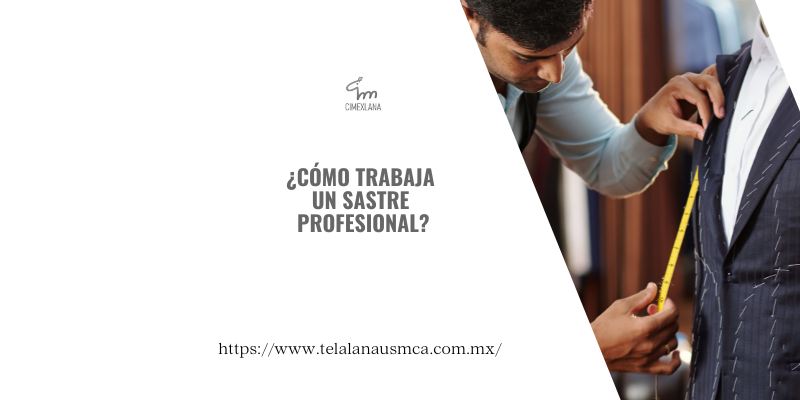
How Does a Professional Tailor Work?
Art and Technique of Custom Tailoring
Introduction
A professional tailor They don't just make clothes, they transform a collection of fabrics into a unique garment, perfectly fitting each client's body and style. The tailor's work combines artisanal tradition, technical knowledge, and a deep understanding of fashion and human anatomy.
In this article we will explore how a professional tailor works, from the first appointment with the client to the final delivery of the suit, in addition to the benefits of choosing a tailoring service over industrial fashion.
The First Stage: Knowing the Client and Their Needs
- A tailor's process begins with a personalized interview. Here, the professional seeks to understand:
- The purpose of the suit: Is it for a special event, everyday use, or a business setting?
- The desired style: Classic, modern, informal or ceremonial.
- Fabric and color preferences: Adjusted to the client's taste and the season of the year.
This first stage is crucial because the tailor's goal is not just to create clothes, but to make a garment that reflects the personality and style of the person who will wear it.
Selecting Fabric and Materials
Once the style is defined, the tailor presents a catalog of fabrics that may include:
- Worsted wool: Ideal for executive and everyday suits.
- Wool with silk or cashmere: For a more luxurious finish.
-
Light or tropical mixes: Perfect for warm climates.
In addition to the main fabric, linings, threads, buttons, and other details are selected to add a unique and personal touch to the garment.
Taking Measurements: Millimeter Precision
One of the most important aspects of a professional tailor's work is taking measurements. It's not just about measuring height, chest, and waist, but also about analyzing:
- Client posture.
- Body proportions.
- Natural fall of the shoulders.
-
Ideal length of sleeves and pants.
This process ensures that the final garment not only looks good, but feels comfortable and provides freedom of movement.
Pattern Design and Creation
With the measurements ready, the tailor proceeds to create a custom patternUnlike industrial clothing, which is made from standard patterns, a tailored suit pattern is made exclusively for a single client.
Key Benefit:
This ensures that every seam and every cut is tailored to the body, avoiding unnecessary adjustments later.
Fabric Cutting: The Art of Precision
The next step is to cut the chosen fabric following the previously designed pattern. This process requires great precision, as an error of just a few millimeters can affect the symmetry and fit of the suit.
Professional tailors typically perform the cutting manually, using specialized scissors and techniques learned over years of experience.
Initial Preparation and Fit Testing
After cutting, a first assembly of the suit is made, known as bastingThis preliminary version of the garment allows:
- Check the general adjustment.
- Review style details such as lapels, pockets, and fabric drape.
-
Make modifications before final preparation.
The client tests this first version and, together with the tailor, makes the necessary adjustments.
Final Confection: Details that Make the Difference
Once the adjustments are approved, the tailor moves on to the final garment. This is where the tailor's artistry truly comes into its own:
- Invisible and reinforced seams to ensure durability
- Hand-sewn buttons precisely.
-
Linings and internal finishes that ensure comfort and elegance.
Manual labor is sometimes combined with modern technology to improve precision, but the artisanal touch remains the hallmark of a professional tailor.
Final Test and Delivery of the Suit
Before delivering the garment, the tailor performs a final fitting with the customer. Here, the following items are reviewed:
- Let the fit be perfect.
- That the proportions and symmetry are correct.
-
That the customer feels comfortable with the garment.
If necessary, minor adjustments are made. Finally, the suit is delivered ready to wear, with care recommendations to prolong its lifespan.
Key Differences Between a Professional Tailor and Industrial Fashion
- Personalization: A tailored suit is made for one person; industrial fashion uses standard measurements.
- Durability: Handmade garments tend to last longer thanks to higher quality materials.
- Unique style: Each suit is unique and reflects the client's personality.
-
Perfect fit: It does not require major subsequent modifications.
Benefits of Choosing a Professional Tailor
- Absolute comfort: The suit fits your body like a second skin.
- Image projection: A well-tailored suit creates a positive impression in the workplace and in society.
- Personalized experience: From fabric selection to the final details, the client is involved throughout the entire process.
-
Sustainability: Less consumption of low-quality garments and more investment in long-lasting pieces.
Care and Maintenance of a Tailored Suit
- A suit made by a professional tailor deserves special care:
- Do not wash it at home: Dry cleaning is recommended.
- Brush it after each use: To remove dust and particles.
- Store on wide hangers: Maintains original shape.
-
Rotate its use: Prevents premature wear.
conclusion
The work of a professional tailor is a combination of art, technique, and dedication. Each custom-made garment tells a unique story: that of a client looking for more than just clothes; they are looking for elegance, comfort, and a unique style.
Choosing a suit made by a professional tailor means investing in quality, image, and confidence, with the security of wearing a unique and exclusive garment.

